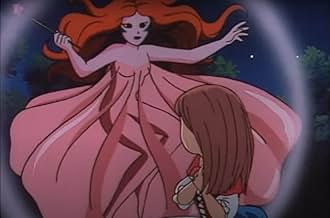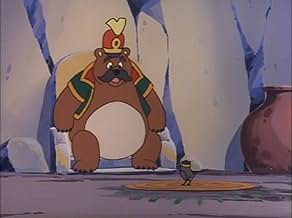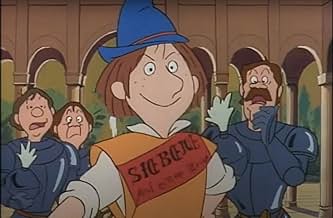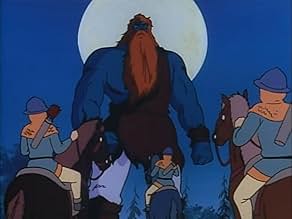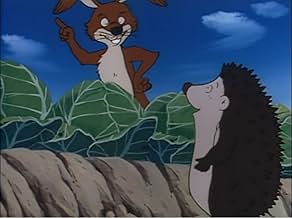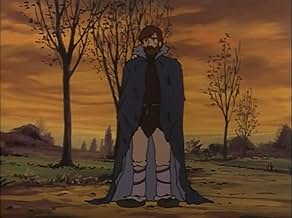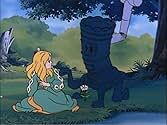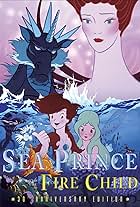IMDb RATING
8.5/10
482
YOUR RATING
An animated series retelling a different folk or fairy tale in each episode.An animated series retelling a different folk or fairy tale in each episode.An animated series retelling a different folk or fairy tale in each episode.
Browse episodes
Storyline
Featured review
For many years, the Japanese animation studio Nippon Animation was very well known for providing anime adaptations of Western literary works. The best example is, of course, the annual "World Masterpiece Theater" serials ("Anne of Green Gables," "Tom Sawyer," "Little Women," "Little Princess Sara" and various others), but that's far from the only example. The show known in North America and shown on Nickelodeon as "Grimm's Fairy Tale Classics" was actually two different series ("Grimm Masterpiece Theater", 1987-88, and "New Grimm Masterpiece Theater," 1988-89) shown in Japan on TV Asahi and redubbed and reedited for U.S. distribution by Saban International. While it wasn't one of Nippon Animation's more popular or well-known series, it has been shown in various European countries as well as the U.S. and is remembered fondly by many who saw it as children, including myself.
This charming anime stands out from the massive crop of animated fairy-tale adaptations on the market due to its production values. Nippon Animation had high standards at the time, and it shows - faces are expressive, there's lots of attention to detail in even minor movements, and the backgrounds are beautifully done. Even with the budgets of TV animation in the late '80s, the show never looks chintzy or sloppy, even though there are scenes (particularly when the narrator is speaking) that do remind us that there WAS a budget (a still frame rather than actual animation). One thing that can be distracting if one is watching this as a series is that the show used four or five character designers, so the character designs and art styles vary widely from one episode to another. But of course, this is an episodic series (few stories cover more than one half-hour episode, with a few exceptions, most notably "Snow White") and meant to be viewed as such, so others may not find this as much of an issue.
Saban's dub is mostly good, but not perfect. The voice acting is very good, and many of the voices will be familiar to those who have watched "Robotech," "Tenchi Muyo!," "Outlaw Star" and "Pokemon" among other shows. The dialogue is often written quite awkwardly, however, as was probably necessary to match the lip flaps. The score by Haim Saban and Shuki Levy, replacing the original music by Hideo Shimazu (which can still be heard in some other foreign dubs, i.e. the German version), is pleasant enough but recycled a bit too frequently, and Shimazu's original beautifully orchestrated score is superior. On the other hand, there are some short songs in a few episodes (i.e. "Jorinde and Joringel" and "The Six Who Went Far") - though this isn't really a "musical" anime - which are quite nicely sung despite occasionally cutesy lyrics. Another memorable moment is when the Big Bad Wolf in "Little Red Riding Hood" breaks into a rap... no kidding.
Which brings me to another of the charming things about this series - the occasional sight gags and in-jokes. One example can be found in the "Briar Rose" (Sleeping Beauty) episode. Look closely at the invitations the witches receive and you'll see they are written in Japanese Romanji in Olde German-style text! (This was kept in the dub, by the way.) Also, one of the other reviewers mentioned the lack of fart jokes in this series. There actually IS a fart joke in the original version of "Jorinde and Joringel" which was cut from the English dub. If you can find the German dub online, watch it and you'll see what I mean. LOL! It's a quite different treatment than the "World Masterpiece Theater" series which were usually quite serious.
Overall, one of the finest adaptations of fairy tales I've seen. Despite the slight imperfections in the dub, I find these equally as enjoyable as anything Disney did. 8.5/10.
This charming anime stands out from the massive crop of animated fairy-tale adaptations on the market due to its production values. Nippon Animation had high standards at the time, and it shows - faces are expressive, there's lots of attention to detail in even minor movements, and the backgrounds are beautifully done. Even with the budgets of TV animation in the late '80s, the show never looks chintzy or sloppy, even though there are scenes (particularly when the narrator is speaking) that do remind us that there WAS a budget (a still frame rather than actual animation). One thing that can be distracting if one is watching this as a series is that the show used four or five character designers, so the character designs and art styles vary widely from one episode to another. But of course, this is an episodic series (few stories cover more than one half-hour episode, with a few exceptions, most notably "Snow White") and meant to be viewed as such, so others may not find this as much of an issue.
Saban's dub is mostly good, but not perfect. The voice acting is very good, and many of the voices will be familiar to those who have watched "Robotech," "Tenchi Muyo!," "Outlaw Star" and "Pokemon" among other shows. The dialogue is often written quite awkwardly, however, as was probably necessary to match the lip flaps. The score by Haim Saban and Shuki Levy, replacing the original music by Hideo Shimazu (which can still be heard in some other foreign dubs, i.e. the German version), is pleasant enough but recycled a bit too frequently, and Shimazu's original beautifully orchestrated score is superior. On the other hand, there are some short songs in a few episodes (i.e. "Jorinde and Joringel" and "The Six Who Went Far") - though this isn't really a "musical" anime - which are quite nicely sung despite occasionally cutesy lyrics. Another memorable moment is when the Big Bad Wolf in "Little Red Riding Hood" breaks into a rap... no kidding.
Which brings me to another of the charming things about this series - the occasional sight gags and in-jokes. One example can be found in the "Briar Rose" (Sleeping Beauty) episode. Look closely at the invitations the witches receive and you'll see they are written in Japanese Romanji in Olde German-style text! (This was kept in the dub, by the way.) Also, one of the other reviewers mentioned the lack of fart jokes in this series. There actually IS a fart joke in the original version of "Jorinde and Joringel" which was cut from the English dub. If you can find the German dub online, watch it and you'll see what I mean. LOL! It's a quite different treatment than the "World Masterpiece Theater" series which were usually quite serious.
Overall, one of the finest adaptations of fairy tales I've seen. Despite the slight imperfections in the dub, I find these equally as enjoyable as anything Disney did. 8.5/10.
- chrbubb-386-447636
- Dec 13, 2014
- Permalink
- How many seasons does Grimm's Fairy Tale Classics have?Powered by Alexa
Details
- Release date
- Countries of origin
- Languages
- Also known as
- Grimm Masterpiece Theatre
- Production company
- See more company credits at IMDbPro
Contribute to this page
Suggest an edit or add missing content

Top Gap
By what name was Grimm's Fairy Tale Classics (1987) officially released in India in English?
Answer

